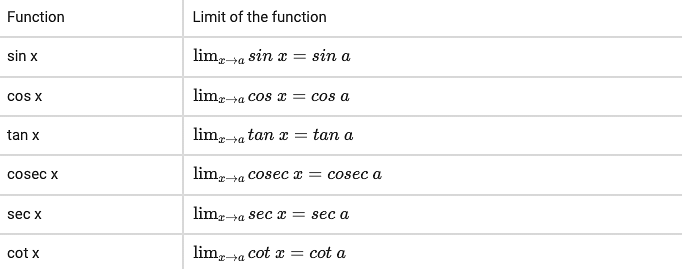\(\begin{array}{l}\displaystyle \lim_{ x\to 0}\left(\frac{(x+2\cos x)^3 + 2(x+2\cos x)^2 + 3 \sin(x+2\cos x)}{(x+2)^3+2(x+2)^2+3\sin(x+2)}\right)^{\frac{100}{x}} \end{array}\)is equal to _________.
Solution and Explanation
Let,
Top Questions on limits of trigonometric functions
- The value of \( \lim_{x \to 0} \left( \frac{\tan 11x}{\tan 5x} \right) \) is:
- GATE MN - 2025
- Engineering Mathematics
- limits of trigonometric functions
- Find the value of the following expression: \[ \tan^2(\sec^{-1}4) + \cot(\csc^{-1}3) \]
- MHT CET - 2025
- Mathematics
- limits of trigonometric functions
- Given a real-valued function \( f \) such that: \[ f(x) = \begin{cases} \frac{\tan^2\{x\}}{x^2 - \lfloor x \rfloor^2}, & \text{for } x > 0 \\ 1, & \text{for } x = 0 \\ \sqrt{\{x\} \cot\{x\}}, & \text{for } x < 0 \end{cases} \] Then:
- BITSAT - 2024
- Mathematics
- limits of trigonometric functions
- Evaluate the limit: \[ \lim_{\theta \to \frac{\pi}{2}} \frac{8\tan^4\theta + 4\tan^2\theta + 5}{(3 - 2\tan\theta)^4} \]
- TS EAMCET - 2024
- Mathematics
- limits of trigonometric functions
- If \( f(x) \) is defined as follows:
\[ f(x) = \begin{cases} \frac{x - \lfloor x \rfloor}{x - 2} & \text{if } x = 2 \\ \frac{|x - \lfloor x \rfloor|}{a^2 + (x - \lfloor x \rfloor)^2} & \text{if } 1 < x < 2 \\ 2a - b & \text{if } x = 1 \end{cases} \]
Then the limit \( \displaystyle \lim_{x \to 0} \frac{\sin(ax) + x \tan(bx)}{x^2} \) is:- AP EAPCET - 2023
- Mathematics
- limits of trigonometric functions
Questions Asked in JEE Main exam
A conducting bar moves on two conducting rails as shown in the figure. A constant magnetic field \( B \) exists into the page. The bar starts to move from the vertex at time \( t = 0 \) with a constant velocity. If the induced EMF is \( E \propto t^n \), then the value of \( n \) is _____.

- JEE Main - 2025
- Magnetic Field
- Concentrated nitric acid is labelled as 75%by mass. The volume in mL of the solution which contains 30 g of nitric acid is: Given: Density of nitric acid solution is 1.25 g/mL.
- JEE Main - 2025
- Solutions
- A physical quantity \( Q \) is related to four observables \( a \), \( b \), \( c \), and \( d \) as follows: \[ Q = \frac{a b^4}{c d^2} \] Where:
- \( a = (60 \pm 3) \, \text{Pa} \),
- \( b = (20 \pm 0.1) \, \text{m} \),
- \( c = (40 \pm 0.2) \, \text{N·s/m}^2 \),
- \( d = (50 \pm 0.1) \, \text{m} \).
Then the percentage error in \( Q \) is:- JEE Main - 2025
- Error analysis
- Let circle $C$ be the image of
$$ x^2 + y^2 - 2x + 4y - 4 = 0 $$
in the line
$$ 2x - 3y + 5 = 0 $$
and $A$ be the point on $C$ such that $OA$ is parallel to the x-axis and $A$ lies on the right-hand side of the centre $O$ of $C$.
If $B(\alpha, \beta)$, with $\beta < 4$, lies on $C$ such that the length of the arc $AB$ is $\frac{1}{6}$ of the perimeter of $C$, then $\beta - \sqrt{3}\alpha$ is equal to: - Assume a living cell with 0.9%(\(w/w\)) of glucose solution (aqueous). This cell is immersed in another solution having equal mole fraction of glucose and water. (Consider the data up to first decimal place only) The cell will:
- JEE Main - 2025
- osmosis
Concepts Used:
Limits of Trigonometric Functions
Assume a is any number in the general domain of the corresponding trigonometric function, then we can explain the following limits.

We know that the graphs of the functions y = sin x and y = cos x detain distinct values between -1 and 1 as represented in the above figure. Thus, the function is swinging between the values, so it will be impossible for us to obtain the limit of y = sin x and y = cos x as x tends to ±∞. Hence, the limits of all six trigonometric functions when x tends to ±∞ are tabulated below:
